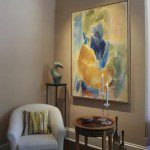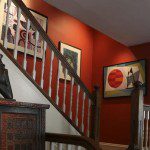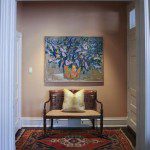Design Central
By • September 10, 2014 0 1479

Displaying art is an opportunity to express your individuality through the beauty and inspiration art brings into your home. You choose a particular piece of art because it gives you pleasure and reflects who you are. It does not need to meet anyone else’s standard of “an important work” or have high monetary value. What matters is that it gives you pleasure and enhances the quality of your life.
Unlike anything else, art allows intimacy with an object. Although the piece may be static, your experience of it is not. Your perception shifts depending on the light at different times of day and season and on your mood. In turn, the art work influences your emotions and state of mind. To fully reap the benefits of surrounding yourself with art, you want to display your pieces in ways that enrich the viewer’s experience and enhances the environment (surroundings).
Displaying art is an art unto itself. In fact, museums and galleries employ design specialists to ensure that the display of their art enhances the work itself. These specialists have four basic concerns: lighting, background, framing, and hanging. The principles of display design apply equally to the home environment. By understanding these principles, you can speak with confidence with your own designers or create harmonious displays of your own.
Lighting
Art needs proper lighting to be appreciated. If possible, hiring a lighting designer is an excellent investment. Good lighting enlivens art, allowing the richness of colors, contours, textures, and other details of the work to attract the eye and awaken interest.
Commonly used design solutions are track lighting and small recessed fixtures. The distance of the light fixture from the wall on which the art is displayed should be approximately one third of the ceiling height. The lamps should “wash” the wall, avoiding the creation of concentrated hot spots of light or shadows on the art work.
Background
Wall Color. Although museums and galleries often use shades of white as display backgrounds, at home you need not feel so confined. Just as the art you select reveals what you consider beautiful and meaningful, the color you choose to complement it and your other furnishings is a personal expression. Black, white, and neutral shades of beige or grey have an architectural neutrality that work particularly well with black and white art and photography. Color photography and paintings or posters can be supported by warm neutral terra cottas and sandy shades, celadon, full saturation greens, and even red or black.
Framing
Simply stated, the frame contains, focuses, and enhances the art. A frame should not overwhelm the art itself. A commercial framer with an experienced eye is an ally worth cultivating. Friends may provide references and, since most shops have samples of their work on display, you can judge for yourself as well. Such a framer can provide you with a selection of mats, framing styles, and molding and advise you on any special requirements for the particular piece. For example, a valuable photograph or work on paper should be framed with only archival materials and museum glass to provide protection from ultraviolet light, prevent fading, and eliminate glare.
If you are framing expensive art, you will not want to spare expense in framing. A frame provides protection for the work as well as enhancement of its visual affect. For less expensive art, ready-made framing may suffice. Reasonably priced frames and mats are available in standard sizes.
Hanging Art
Ideally, you hang art so the center of the picture is fifty-seven inches above the floor. The fifty-seven inch standard represents the average human’s eye height and is regularly used as a standard in galleries and museums. By using this method you create a harmony among all the pictures in your home as they will hang in relationship to one another from their centers, not their sides, and you will also avoid the single greatest error, that of hanging art too high.
Other considerations for hanging art:
• Hang the correct scale of artwork on a wall so that it is seen but does not appear stuffed into the space. Art needs to “breathe.” For example, don’t hang a large painting on a narrow hall wall.
• Allow six to eight inches of space between pieces horizontally. You may take advantage of a vertical wall and double or triple hang art on it with a few inches of space in between. The art pieces should be of the same relative strength in color saturation and composition, yet not overpower one another. Create harmony among the works by ensuring that the subjects, colors, and sizes relate to one another.
• To make your environment beautifully personal as well as aesthetically interesting, show various art forms together in the same space: painting, sculpture, photography, crafts, textiles.
Above all, remember to relax and enjoy your art, one piece or ten, whatever style or medium, let it inspire and teach you.
www.denaverrillinteriors.com
(202) 333-3551
- Art is the focus in this entry way. Note the warm beige background wall color. | Paul Simkin
- Jordan Wright
- Jordan Wright






